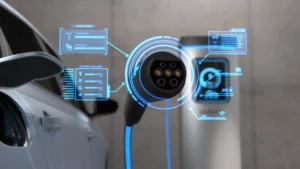
Home / EV Charging News / Top 5 Reasons to Install an EV Charging Station at Home in 2025
As electric vehicles (EVs) continue to reshape the global transportation landscape, 2025 is shaping up to be a pivotal year for EV ownership. Governments are intensifying their commitment to clean energy, automakers are releasing new models at a record pace, and home energy technologies are becoming smarter and more affordable. One major component of this transition is the growing adoption of home EV charging stations.
Installing a Level 2 EV charger at home offers unparalleled convenience, long-term cost savings, and enhanced energy control. In this article, Nick Zamanov, EV infrastructure expert at CyberSwitching, explores the top five reasons why 2025 is the ideal time to invest in a home EV charging station and how it can prepare your home for the future of transportation.
Home charging stations eliminate the need for daily trips to public charging facilities, providing a reliable and hassle-free way to keep your EV ready for the road.
While many EV owners start with a standard 120V Level 1 charger, upgrading to a 240V Level 2 charger can reduce charging times by up to 75%. Depending on your EV model and charger output, you can add 20–40 miles of range per hour—allowing a full overnight charge even from a near-empty battery.
With a home EV charging station, you simply plug in your vehicle when you return home, and by morning, you’re ready to go. No lines. No wait times. No range anxiety.
Federal, state, and utility-based incentives are making home EV charger installation more affordable than ever. In the U.S., the federal EV charger tax credit—revived and extended under the Inflation Reduction Act—offers up to 30% of the installation cost, capped at $1,000 for residential properties.
Many local utility companies also offer rebates or time-of-use (TOU) electricity rate plans to encourage home EV charging during off-peak hours, which further reduces your energy bill.
However, these incentives are not guaranteed to last forever. As EVs become mainstream, subsidy programs may be scaled back or eliminated altogether.
Charging at home is almost always cheaper than relying on public charging networks. By installing a smart EV charger, you can monitor your energy use, schedule charging during off-peak hours, and take advantage of dynamic energy pricing.
For example, using a TOU rate plan in California, a homeowner charging at night might pay less than $0.15 per kWh, compared to public fast charging stations that often charge $0.40 to $0.60 per kWh or more. Over the lifespan of your vehicle, that translates into thousands of dollars in savings.
CyberSwitching’s smart chargers also allow integration with solar panels or home battery systems, enabling you to charge your vehicle using clean, self-generated energy—and even store power during the day for use at night.
In 2025, EV readiness is quickly becoming a must-have feature for modern homes. Buyers are increasingly looking for properties that offer EV infrastructure, particularly in EV-dense regions like California, New York, and parts of Europe.
According to studies, homes with Level 2 EV chargers can sell for a higher price and often attract more buyer interest. Adding this upgrade signals that your home is future-ready, energy-efficient, and tech-savvy—qualities that today’s homebuyers highly value.
Additionally, many smart chargers, like those developed by CyberSwitching, offer aesthetic design, Wi-Fi connectivity, and app control, making them desirable upgrades that blend functionality with innovation.
Home EV chargers aren’t just plug-and-play devices—they’re key components of the future smart grid. As the world transitions toward decentralized, digital energy systems, EVs are evolving into energy storage assets capable of interacting with homes and the grid.
CyberSwitching’s next-generation smart chargers are equipped for Vehicle-to-Home (V2H) and Vehicle-to-Grid (V2G) integration, allowing homeowners to feed energy back into their homes during outages or to the grid during peak demand times (where permitted).
Pairing your charger with smart home systems, rooftop solar, and energy storage not only maximizes efficiency—it also supports grid stability and can generate additional income through energy arbitrage programs.
“2025 represents a turning point for both electric vehicles and home energy systems. Installing a smart home EV charger is not just a lifestyle upgrade—it’s an investment in energy independence, cost savings, and environmental responsibility,” says Nick Zamanov, EV infrastructure expert at CyberSwitching. “The earlier you adapt, the more you benefit.”
CyberSwitching provides reliable, scalable, and smart EV charging solutions tailored for residential use. Whether you’re buying your first EV or future-proofing your smart home, we’ll help you install a charger that delivers performance, savings, and peace of mind.
Contact us today to learn how a CyberSwitching home charging solution can power your EV journey in 2025 and beyond.
A: Level 1 chargers use standard 120V household outlets and charge slowly (about 3–5 miles per hour). Level 2 chargers require a 240V outlet and charge much faster (20–40 miles per hour), making them ideal for daily use.
A: Costs vary based on your home’s electrical setup but typically range from $800 to $2,000 (before incentives). This includes the charger unit and professional installation.
A: Yes. Smart chargers offer scheduling, energy monitoring, remote access, and integration with other systems like solar panels—making your charging routine more efficient and cost-effective.
A: It’s strongly recommended to hire a licensed electrician, especially for Level 2 chargers that require dedicated 240V circuits and permitting. DIY installation may void warranties and pose safety risks.
A: Most high-quality chargers last 5–10 years or more with proper maintenance. Many manufacturers, including CyberSwitching, offer warranties and remote support services.



